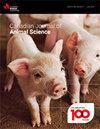气候变化对加拿大奶牛热应激风险的趋势
IF 1
4区 农林科学
Q3 AGRICULTURE, DAIRY & ANIMAL SCIENCE
引用次数: 0
摘要
加拿大的气候变暖速度快于全球平均水平,但变暖分布不均。这项研究分析了加拿大奶牛产区的历史和未来气候变化,以更好地了解加拿大奶牛是如何受到影响的。使用来自全国29个气象站的温度和湿度数据评估了历史变化(即1960年至2019年)。温湿度指数(THI)被用作奶牛面临热应激风险的指标,三个THI指标评估了潜在热应激的频率、严重程度和持续时间。使用五个全球气候模型对未来情景进行了调查,以预测三个共享社会经济路径(SSP)下的每日THI。预测分为三个时间段(2020-2049、2040-2069和2060-2089)。历史气候趋势显示,加拿大西海岸和东部大部分地区的温度、湿度和THI超标率都有所上升,影响了84%的全国奶牛群。未来的情景预测,在除最乐观的SSP外的所有情况下,90%的全国牛群将经历THI超标的频率、严重程度和持续时间的大幅增加。这些发现强调了加拿大奶农考虑热应激适应策略的必要性。本文章由计算机程序翻译,如有差异,请以英文原文为准。
Trends in the risk of heat stress to Canadian dairy cattle in a changing climate
Canada’s climate is warming faster than the global average, but the warming is unevenly distributed. This study analyzes historical and future climate change in dairy producing regions across Canada to better understand how Canada’s dairy cows are affected. Historical changes (i.e., 1960 - 2019) were assessed using temperature and humidity data from 29 weather stations across the country. The temperature humidity index (THI) was used as an indicator of dairy cattle at risk of heat stress, and three THI metrics evaluated the frequency, severity, and duration of potential heat stress. Future scenarios were investigated using five global climate models to project daily THI under three Shared Socioeconomic Pathways (SSPs). Projections were grouped into three time periods (2020-2049, 2040-2069, and 2060-2089). Historical climate trends show an increase in temperature, humidity, and THI exceedance in most west coast and eastern Canada locations, affecting 84% of the national dairy herd. Future scenarios project that 90% of the national herd will experience a large increase in the frequency, severity, and duration of THI exceedance under all but the most optimistic SSP. These findings highlight the need for Canadian dairy farmers to consider heat stress adaptation strategies.
求助全文
通过发布文献求助,成功后即可免费获取论文全文。
去求助
来源期刊

Canadian Journal of Animal Science
农林科学-奶制品与动物科学
CiteScore
2.30
自引率
0.00%
发文量
51
审稿时长
6 months
期刊介绍:
Published since 1957, this quarterly journal contains new research on all aspects of animal agriculture and animal products, including breeding and genetics; cellular and molecular biology; growth and development; meat science; modelling animal systems; physiology and endocrinology; ruminant nutrition; non-ruminant nutrition; and welfare, behaviour, and management. It also publishes reviews, letters to the editor, abstracts of technical papers presented at the annual meeting of the Canadian Society of Animal Science, and occasionally conference proceedings.
 求助内容:
求助内容: 应助结果提醒方式:
应助结果提醒方式:


